
The Boletaceae are a family of mushroom-forming fungi, primarily characterised by small pores on the spore-bearing hymenial surface, instead of gills as are found in most agarics. Nearly as widely distributed as the agarics, the family is renowned for hosting some prime edible species highly sought after by mushroom hunters worldwide, such as the cep or king bolete . A number of rare or threatened species are also present in the family, that have become the focus of increasing conservation concerns. As a whole, the typical members of the family are commonly known as boletes.

Rubroboletus satanas, commonly known as Satan's bolete or the Devil's bolete, is a basidiomycete fungus of the bolete family (Boletaceae) and one of its most infamous members. It was known as Boletus satanas before its transfer to the new genus Rubroboletus in 2014, based on molecular phylogenetic data. Found in broad-leaved and mixed woodland in the warmer regions of Europe, it is classified as a poisonous mushroom, known to cause gastrointestinal symptoms of diarrhea and violent vomiting. However, reports of poisoning are rare, due to its striking appearance and at times putrid smell, which discourage casual experimentation.

Neoboletus luridiformis, also previously known as Boletus luridiformis and (invalidly) as Boletus erythropus, is a fungus of the bolete family, all of which produce mushrooms with tubes and pores beneath their caps. It is found in Northern Europe and North America, and is commonly known as the scarletina bolete, for its red pores. Other common names is: red foot bolete, dotted stemmed bolete, dotted stem bolete.

Rubroboletus pulcherrimus—known as Boletus pulcherrimus until 2015—is a species of mushroom in the family Boletaceae. It is a large bolete from Western North America with distinguishing features that include a netted surface on the stem, a red to brown cap and stem color, and red pores that stain blue upon injury. Until 2005 this was the only bolete that has been implicated in the death of someone consuming it; a couple developed gastrointestinal symptoms in 1994 after eating this fungus with the husband succumbing. Autopsy revealed infarction of the midgut.
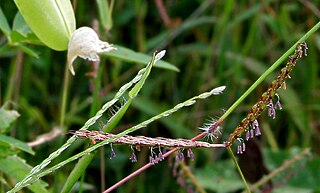
Ischaemum is a genus in the tribe Andropogoneae, belonging to the grass family, widespread in tropical and semitropical regions in many countries. Many species are known commonly as murainagrass.

Rubroboletus eastwoodiae, or satan's bolete, is a toxic basidiomycete fungus of the bolete family. It occurs on the West Coast of the United States. It is closely related to Rubroboletus pulcherrimus.
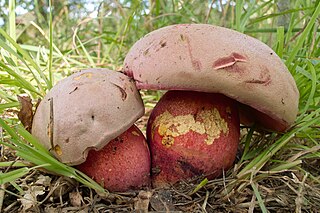
Rubroboletus legaliae, previously known as Boletus splendidus, B. satanoides, and B. legaliae is a basidiomycete fungus of the family Boletaceae. It is poisonous, with predominantly gastrointestinal symptoms, and is related to Rubroboletus satanas.
Phytotaxa is a peer-reviewed scientific journal for rapid publication on any aspect of systematic botany. It publishes on a wide range of subjects, but focuses on new species, monographs, floras, revisions, reviews, and typification issues. Phytotaxa covers all plant groups covered by the International Code of Nomenclature for algae, fungi, and plants, including diatoms, fungi, algae, lichens, mosses, hornworts, liverworts, and vascular plants), both living and fossil.

Rubroboletus rhodoxanthus is a species of bolete in the family Boletaceae, native to Europe. Previously known as Boletus rhodoxanthus, it was transferred in 2014 to the newly erected genus Rubroboletus, based on DNA data.
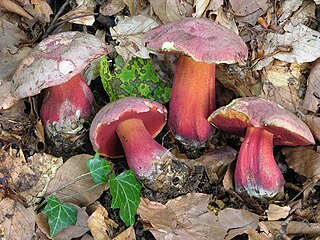
Rubroboletus rubrosanguineus is a species of bolete fungus in the family Boletaceae that is found in Europe.
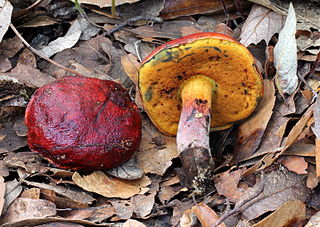
Rubroboletus dupainii, commonly known as Dupain's bolete, is a bolete fungus of the genus Rubroboletus. It is native to Europe, where it is threatened, and red listed in six countries. It also occurs in North America, although it is rare there. It was first recorded from North Carolina, and then from Iowa in 2009. It was reported from Belize in 2007, growing under Quercus peduncularis and other oaks.

Rubroboletus rhodosanguineus is a fungus of the genus Rubroboletus native to North America. It was described scientifically by mycologist Ernst Both in 1998. It was transferred from Boletus to the new genus Rubroboletus in 2014, along with several other allied reddish colored, blue-staining bolete species.

Rubroboletus sinicus is a bolete fungus in the family Boletaceae. It is found in China. The species was first described by Wei Fan Chiu as Boletus sinicus in 1948, and transferred to the genus Tylopilus in 1979 by Fanglan Tai. In 2014, the genus Rubroboletus was created to accommodate this and allied species.

Rubroboletus is a genus of bolete fungi in the family Boletaceae. It was circumscribed by Chinese mycologists in 2014 with Rubroboletus sinicus as the type species. Species are characterized by having a reddish cap surface, yellow tubes on the underside of the cap, and an orange-red to blood-red pore surface. Pinkish to red spots (reticula) are present on the stipe surface, and a bluish color change occurs when the bolete flesh is injured. Rubroboletus mushrooms have an olive-brown spore print, and produce smooth spores. Eight species were included in the original circumscription ; five were added in 2015, and another in 2017.
Rubroboletus pulchrotinctus is a rare bolete fungus in the genus Rubroboletus, native to central and southern Europe. It was originally described in genus Boletus by Italian mycologist Carlo Luciano Alessio in 1985, but subsequently transferred to genus Rubroboletus by Zhao and colleagues (2015), on the basis of molecular evidence. Phylogenetically, R. pulchrotinctus is the sister-species of the better known Rubroboletus satanas, with which it shares several morphological features.
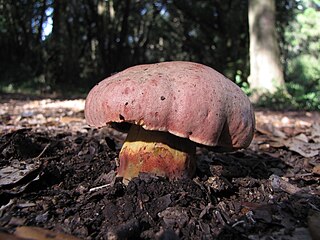
Rubroboletus lupinus, commonly known as the wolf bolete, is a bolete fungus of the genus Rubroboletus. Originally described by Elias Magnus Fries in 1838 as species of Boletus, it was transferred to Rubroboletus in 2015, a genus circumscribed to host other allied reddish-colored, blue-staining bolete species forming a distinct clade. The species epithet is derived from the Latin word lupus, meaning "wolf".
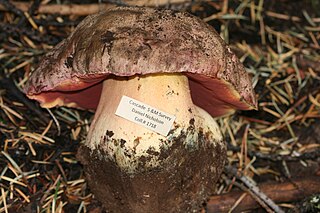
Rubroboletus haematinus is a bolete fungus of the genus Rubroboletus. First described scientifically in 1976 by Roy Halling as a species of Boletus, in 2015 it was transferred to Rubroboletus, a genus circumscribed the year previously to contain other allied reddish colored, blue-staining bolete species. It is found in the western United States.
Rubroboletus esculentus is a bolete fungus in the family Boletaceae. It is found in southwestern China.

Trichotheliaceae is a family of lichen-forming fungi in the order Gyalectales. The family was circumscribed by Friedrich von Schilling and Friedrich August Georg Bitter in 1927.














